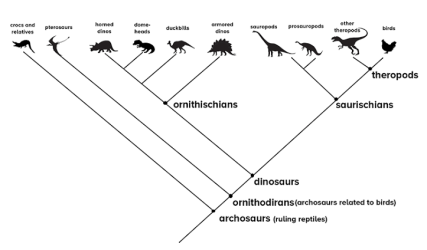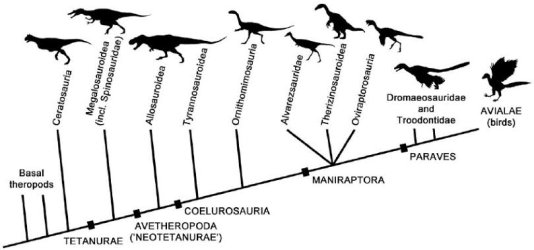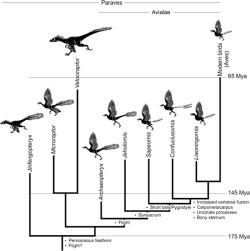The widespread adoption of phylogenetics as the basis of classification in palaeontology occurred about 40 years ago I think, so it has been around for a while. Of course evolutionary relationships were studied long before, but the classification system was Linnaean until a conscious effort was made to switch over. So it is fairly longstanding. That said, when I was a kid in the early 2000s devouring books about dinosaurs a lot of them said they were cold-blooded, decades after the community started to accept the warm-blooded hypothesis, so the vestiges of old/traditional paradigms probably hang around longer in palaeontology than in other sciences and even more so in pop palaeontology.
Phylogenetic relationships are categorised using phylograms (with branches whose lengths vary based on the degree of evolutionary change) and cladograms (with branches of the same length, designed to only show the ancestors/branching points and not the degree of change). This is a phylogram of archosaurs, the ancestors of dinosaurs and some other ancient animals, including birds and crocodiles:
View attachment 450390
You can see here the major division of dinosaurs into ornithiscians and saurischians. Theropods were saurischians and are generally speaking the bipedal dinosaurs we think of. Then, if you take a cladogram of theropods:
View attachment 450389
There is a clade within the theropods called the paraves. Going further, a 'cladogram' of paraves with years written in and the inclusion of modern birds:
View attachment 450391
It's not a true cladogram in the strict sense and doesn't label the families within paraves but rather just singles out examples and describes some typical features at the points of diversion. The velociraptor/microraptor family is the dromaeosauridae and between archaeopteryx and velociraptor I would also add troodontidae. If you take the type species of those two families, dromaeosaurus and troodon, and compare them to archaeopteryx, there are a lot of similarities in body design. I note this because archaeopteryx is the classic transitional fossil between birds and dinosaurs but I think some people don't realise that it had a lot more similarities to the two aforementioned terrestrial families.
Archaeopteryx likely couldn't fly very well. Its musculature wouldn't have been conducive to flapping so it likely glided more than it flapped and it would've likely needed a fairly decent run up (like a 747 taxiing) before it could take off. I'm not sure how the Linnaean system handles dinosaurs and birds together but roughly speaking I'd imagine it would put archaeopteryx closer to modern birds, or at least imply archaeopteryx is more similar to modern birds than to dromaeosauridae, which is not accurate evolutionarily speaking.
The groups to the right of archaeopteryx are the ones even closer in evolutionary relationship to modern birds than archaeopteryx. The four animals in this diagram are all from the Cretaceous period. There is a label "short tail/pygostyle" - a pygostyle is a section of fused vertebrae that allowed for the development of short-tailed animals. The long to short tail transition is very important in bird evolution as modern birds have short tails. A very recent discovery (from 2023, but the interpretation of that discovery is so recent the some of the relevant Wikipedia pages haven't been updated) of a creature called baminornis shows a pygostyle, so it would belong somewhere in between sapeornis and confuciusornis in this diagram. The interesting thing about baminornis is that it was from the
Jurassic, and it was the contemporary of if not
older than archaeopteryx. So that could have a lot of implications for when exactly modern birds started to evolve, although with the caveat that pygostyles likely evolved twice independently and there is debate currently on where baminornis would fit into the phylogenetic tree.
You could go further into avialae cladograms but I'll leave the lecture there. I hope that answers your question, if I understood it correctly. I have fact checked but there might still be inaccuracies, but I hope at least it gives a broad overview of bird evolution and how it's classified in palaeontology.




















